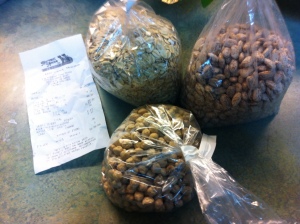For the sake of clarity: I am using the terms SNAP (the national Supplemental Nutrition Assistance Program) and CalFresh (what we call SNAP in California) interchangeably. Both were formerly known as Food Stamps.
Groceries are expensive. It’s something I passively think when I turn down olives for $9 a pound or goat cheese at Safeway (because it’s half the price at Trader Joe’s). Hardly in line with the Hunger Challenge of $4 a day I am embarking on next week, but I do make an effort to be a budget foodie.
If I learned anything from taking the Challenge last year it’s that shopping on a SNAP budget takes planning to max out $22 without going over, you’re going to have to cook, and you’re going to be eating a lot of the same meals in the week. SNAP is meant to be a supplement to an existing grocery budget, but sometimes it’s the only money left for food in a month, so that is the idea during the Challenge. A smart Challenge shop includes enough protein to keep your blood sugar even, fiber so you feel full and satisfied, then try to throw a variety of veggies in the mix all while spending as little as possible. Let’s face it, that is going to take some work, but I’ve got a few tips to make the most of your Challenge funds.
Rachel’s Savvy Shopper Tips
Make a list and stick to it.
Base your shopping list on key ingredients that can be used in a variety of ways, while keeping in mind your need for protein, fiber and vitamins.
Find the blank Hunger Challenge Shopping Log here.
Buy versatile items.
Beans – at 7g protein and more than 7g fiber per half cup, it’s no wonder beans are a staple food all over the world. They can be put on salads, mashed into a paste on a sandwich, put into soups, mixed in a frittata or rolled into a burrito. Do your budget a favor and buy bulk, dry beans. Canned beans may only be $0.89 a can, but 2 pounds of dry beans is only a dollar and makes way more than the 1.3/4c in that can.
Rice – also a protein stunner, brown rice has 5g of protein in a 1 cup serving. Mix it with your beans for a budget classic that’ll fill you up.
Eggs – 6 grams of protein, Vitamin A, B12, Selenium and 100 ways to cook em.
Canned Tuna
Frozen Veggies
Long Lasting Veggies – like onions, sweet potatoes, cabbage and greens.
Check the unit price.
That smaller size may be cheaper dollar for dollar, but if you have the funds to buy larger quantities you will actually be saving money and able to use the ingredient over several meals. Find the unit price by dividing the price by the total weight or quantity.
Be careful of each vs. per pound and BOGO vs. 2 for $5
There is a big difference between $1 each and $1 per pound. If produce is being sold at an “each” price and it’s a good deal, buy the biggest one. A bogo (buy one get one) might seem tempting, but be sure to check the sale price against the unit price to make sure you’re actually getting a deal (Pistachios for example, were BOGO, but still almost $1/oz, so not a good deal!).
Buy the store brand.
Shop around.
Check the weekly ads and shop the store with the best deals. If someone is having a huge sale on protein, it’s a good item to buy for the freezer. It will take time to know what the best deals are, but you’ll learn your basics like the best deal on peanut butter or chicken breasts. I thought $1.50 was a good price for brown rice until I saw it at Grocery Outlet for $0.69. Shopping around takes effort, but when you get used to it, you can plan your list around the stores with items you like at prices you can afford. Grocery Ads come out every Sunday, but you can often find them online.
Clip coupons.
I am terrible at remembering my coupons, especially if they are for small amounts like $0.40, but if you only have $22 for groceries in a week, get clipping, honey! Safeway also has a Just for U coupon site that lets you add specials to your card that are even below the club card yellow tag you see in store. I buy the super sale items and then leave because they are just hoping you buy the expensive non-sale stuff while you are there.
Avoid prepared foods.
Not just the high-sodium, high calorie, processed junk, but items like bagged lettuce and precooked rice. You can get a head of romaine for $0.79-$0.99 depending on the place, so paying $3.49 for fewer ounces of pre-chopped lettuce is just plain silly ($1.99 at TJs if you’ve been a good student). Scratch cooking is going to save you the most money and it’s a whole lot healthier.
Here is the shopping list I came up with for this year’s Challenge. I added way more veggies than last year, but still far fewer than one should eat in a week.
Leave you favorite budget shopping tips in the comments.
Other great budget shopping resources:
5 Dollar Dinners has a wealth of budget tips from shopping to cooking as well as food allergies on a budget.
http://www.5dollardinners.com/category/meal-planning
10 great tips and insights on budget grocery shopping:
http://www.wisebread.com/10-things-ive-learned-from-grocery-shopping-on-a-budget
More savings tips on popular grocery store items: http://www.goodhousekeeping.com/family/budget/grocery-shopping-on-budget
If you would like to take the Hunger Challenge with Food Bank of Contra Costa staff and supporters, sign up on the Hunger Challenge page of the Food Bank website.



